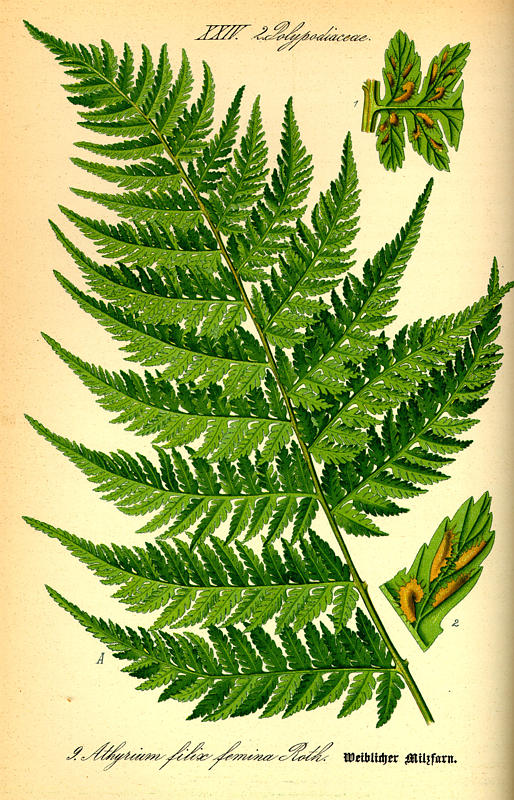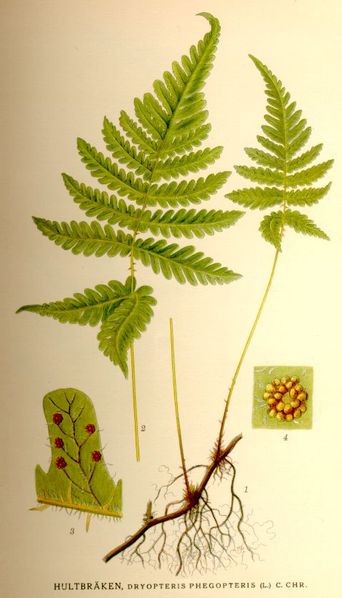Why Ferns are Hard to Identify
Reason No. 1: Language Clarity
"When I use a word," Humpty Dumpty said in rather a scornful tone, "it means just what I choose it to mean, neither more nor less."
- pinnatifid. Pinnately cut, more than half way to the midvein, Mickel, Lower Vascular Plant Glossary.
- pinnatifid. Pinnately cleft, Billington, Ferns of Michigan; also Cody and Britton, Ferns and Fern Allies of Canada
- pinnatifid. Deeply lobed, but not cut to the axis, Lellinger, Ferns and Fern Allies of the United States and Canada
- pinnatifid. Incised nearly all the way to the axis, with the segments not contracted at the base, Lellinger, A Modern Multilingual Glossary for Taxonomic Pteridology
- pinnatifid. Cut half to three-fourths to the rachis, Hoshizaki, Moran, Fern Grower's Manual
- pinnatifid. Once divided with the divisions extending one-quarter to half way to the rachis, Jones, Encyclopaedia of Ferns
- pinnatifid: Cut deeply (but not to midrib) into lobes that are spaced out along the axis, Flora of Australia
Unique? Is it only pinnatifid that causes trouble? Divergent descriptions are quite common. The fern at the right, Dryopteris dilatata, has been called:
- bipinnate, The Ferns of Britain and Ireland, C.N. Page
- tripinnate, The Plantfinder's Guide to Garden Ferns, M. Rickard
- two to three times divided, Ferns for American Gardens, J. Mickel
- tripinnatifid to 4-pinnatifid, Flora of Taiwan
Yes, they were not all looking at this picture. Does that help us?
If we cannot agree on the meaning of our words, or we cannot agree on the plant we are talking about, what common ground is there to begin a discourse?
No. 2: Taxonomic Disputations
Proposed names for the Lady Fern. Current winner:
Athyrium filix-femina (L.) Roth; Tent. Fl. Germ. 3: 65 (1799)
Runners up:
- = Allantodia axillaris Kaulf.; Enum. 178 (1824)
- = Aspidium axillare Sw.; Schrad. Journ. 1800(2). 42 (1801)
- = Aspidium cordatum Steud.; Nomencl. 2. 61 (1824)
- = Aspidium filix-femina (L.) Sw.; Schrad. Journ. 1800(2). 41 (1801)
- = Aspidium intermedium Link; Enum. alt. 2. 459 (1822)
- = Aspidium irriguum Sm.; Engl. Bot. 81 t. 2199 (1810)
- = Aspidium pontederae Willd.; Sp. 5. 273 (1810)
- = Aspidium rhaeticum Willd.; Sp. 6. 280 (1810) p. p.
- = Aspidium rheticum Sw.; Schrad. Journ. 1800(2). 41 (1801) p. p.
- = Asplenium axillare J. Sm.; Bot. Mag. 72. Comp. 30 (1846)
- = Asplenium cyathioides Bernh.; Schrad. Journ. 1799(1). 313 (1799)
- = Asplenium filix-femina Bernh.; Schrad. neu. Journ. 12. 26, 48 t. 2 f. 7 (1806)
- = Asplenium martensii Kze.; Amer. Journ. Sci. II. 6. 86 (1848)
- = Asplenium monstrosum Kze.; Linn. 23. 235, 305 (1850)
- = Athyrium acrostichoideum Bory; Mérat, Fl. Paris. ed. IV. 1. 372 (1836)
- = Athyrium axillare Presl; Tent. 98 (1836)
- = Athyrium azoricum Fée; Gen. 186 (1850-52)
- = Athyrium convexum Newm.; Phytol. 4. app. XIII (1851)
- = Athyrium corsicum Fée; Gen. 186 (1850-52)
- = Athyrium depauperatum Schum.; En. pl. Saell. 2. 17 (1803)
- = Athyrium ensiferum Ching & H.S. Kung in Ching & Y.T. Hsieh (1986)
- = Athyrium filix-femina (L.) Roth; Tent. Fl. Germ. 3: 65 (1799)
- = Athyrium filix-femina var. deltoideum Mak.; Bot. Mag. Tokyo 13. 30 (1899)
- = Athyrium fimbriatum Dulac; Fl. Hautes-Pyrenees 33 (1867)
- = Athyrium galeottii Fée; Gen. 187 (1850-52)
- = Athyrium incisum Newm.; Phytol. 4. app. XIII (1851)
- = Athyrium irriguum Gray; Nat. Arr. br. Pl. 2. 10 (1821)
- = Athyrium laetum Gray; Nat. Arr. br. PI. 2. 10 (1821)
- = Athyrium laxum Schum.; Enum. Pl. Saell. 2. 16 (1803)
- = Athyrium molle (Schreb.) Roth; Tent. Fl. Germ. 3: 61 (1799), et Röm. Mag. 2(1). 106 (1799)
- = Athyrium molliusculum Baumg.; Enum. stirp. Transs. 4. 31 (1846)
- = Athyrium officinale Bubani; Fl. Pyr. 4. 430 (1901)
- = Athyrium ovatum Roth; Röm. Mag. 2(1). 106 (1799)
- = Athyrium paramicola L. D. Gomez; Phytologia 52(3): 154 (1982)
- = Athyrium rhaeticum (L.) Roth; Tent. Fl. Germ. 3: 67 (1799), et Röm. Arch. 2(1). 106 (1799)
- = Athyrium scorpioideum Chauvin; Mém. Soc. Linn. Calvados 402 (1825)
- = Athyrium trifidum (Hoffm.) Roth; Tent. Fl. Germ. 3: 63 (1799), et Röm. Mag. 2(1). 106 (1799)
- = Cyathea filix-femina Bertol.; Amoen. Ital. 429 (1819)
- = Cystopteris filix-femina Coss. & Germ.; Fl. Paris 676 (1845)
- = Filix bipinnata Gilib.; Exerc. Phyt. 2. 557 (1792)
- = Lastrea filix-femina (L.) Colomb; Compt. rendus 107. 1013 (1888)
- = Nephrodium filix-femina (L.) Michx.; Fl. bor. Am. 2. 268 (1803)
- = Phegopteris plumosa J. Sm.; Ferns br. and for. 289 (1866)
- = Polypodium axillare Ait.; Hort. Kew 3: 466 (1789)
- = Polypodium bifidum Hoffm.; Röm. et Usteri Mag. 9: 10 (1790)
- = Polypodium crenatum Schrank; Baier. Flora 2: 426 (1789)
- = Polypodium dentatum Schrank; Baier. Flora 2: 426 (1789)
- = Polypodium femina L.; Mantissa 2: 506 (1771)
- = Polypodium filix-femina L.; Sp. Pl.: 1090 (1753) [basion.
- = Polypodium incisum Hoffm.; Roem. & Ust., Bot. Mag. 9: 10, f. 13b (1790)
- = Polypodium laetum Salisb.; Prod. 403 (1796)
- = Polypodium leseblii Mérat; Fl. Paris ed. II. 276 (1821)
- = Polypodium molle Schreb.; Spic. Fl. Lips. 70 (1771)
- = Polypodium oblongo-dentatum Hoffm.; Roem. et Ust. Mag. Bot. 9: 10 (1790)
- = Polypodium ovato-crenatum Hoffm.; Roem. et Ust. Mag. Bot. 9: 10 (1790)
- = Polypodium rhaeticum L.; Sp. 2: 1091 (1753) p. p.
- = Polypodium trifidum Hoffm.; Röm. et Ust. Mag. 9: 10 (1790)
- = Tectaria filix-femina Cav.; Anal. Cienc. 4: 100 (1801)
From The Checklist of World Ferns by Michael Hassler (Germany) and Brian Swale (NZ).
Sixty-two names since 1753 for one taxon (today's standard), an average residency in the hot spot of 251/62 or 4 years. Earlier years are hotter, but the scene is far from settled.
Related and pertinent: many species on this web site have resided in five or more genera.
No. 3: Publisher ParsimonyHere, in its entirety, is one entry in a popular fern reference: Dryopteris ludoviciana Southern Shield Fern North America 60-120 cm: 1 pinnate Temp-S.Trop.: Terr. A hardy fern of wet soils; in forests sometimes growing on limestone. Plants form an erect tussock of dark green, leathery fronds. Cultivated plants need plenty of water. Let's extract the descriptive content: Yes, full descriptions cost time and money, but what can one do with this? Identify a fern? |
No. 4: Descriptive BrevityTaxonomists approach description from a different perspective -- top down. Here is the entire entry for Osmunda in the Flora of North America: Plants terrestrial. Stems creeping; tips often somewhat erect. Leaves dimorphic; fertile leaves erect, often notably smaller than sterile leaves in length and width. Blades 1–2-pinnate; pinnae monomorphic to dimorphic, pinnatifid or pinnate. Why so frugal? The real description is given with the family definition. Amateurs like us may arrive at the scene of the crime from the species definition, but salvation is not obvious. |
No. 5: Ostrich Behavior
 Linnaeus assigned the name Polypodium dryopteris to a circumboreal fern in his 1753 Species Plantarum. A hundred years later, Newman proposed a new genus, but it did not meet acceptance, and this fern bounced around among twelve genera until the pteridologist Ching resurrected Newman's Gymnocarpium in 1933.
Linnaeus assigned the name Polypodium dryopteris to a circumboreal fern in his 1753 Species Plantarum. A hundred years later, Newman proposed a new genus, but it did not meet acceptance, and this fern bounced around among twelve genera until the pteridologist Ching resurrected Newman's Gymnocarpium in 1933.
What Newman and Ching saw in Gymnocarpium dryopteris was a distinctly different fern, what everyone who looks at a real live oak fern sees first: the abrupt turn of the axis as the vertical stipe becomes the horizontal rachis. Even if their vocabulary does not include stipe and rachis, they are ahead of the taxonomist because they can see vertical and horizontal.
Whether a bend in the axis merits generic novelty is beside the point. What is to the point: herbarium specimens, the sin qua non for flora writers, obscure an important characteristic, the 3-D of life. Many a diagnosis fails to mention the dimensional aspects of ferns.
Actually, it is worse. Too frequently, floras based upon the herbarium report imaginary sightings. To wit, pinnae are described as imbricate, or overlapping, when it is not true at all. Pinnae held horizontally on the vertical stipe are twisted out of that plane onto the herbarium sheet.
Dirty laundry in the world of ferns. Comments invited.